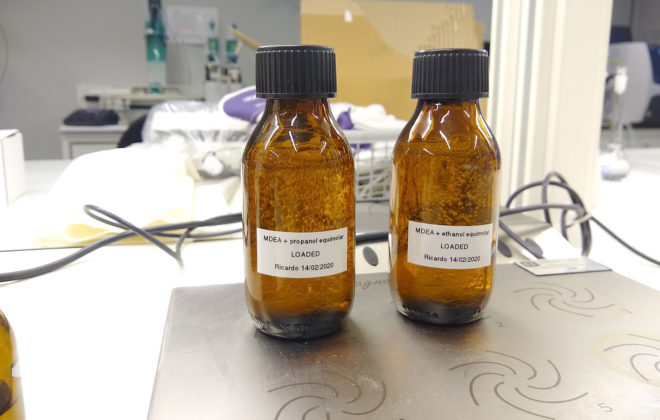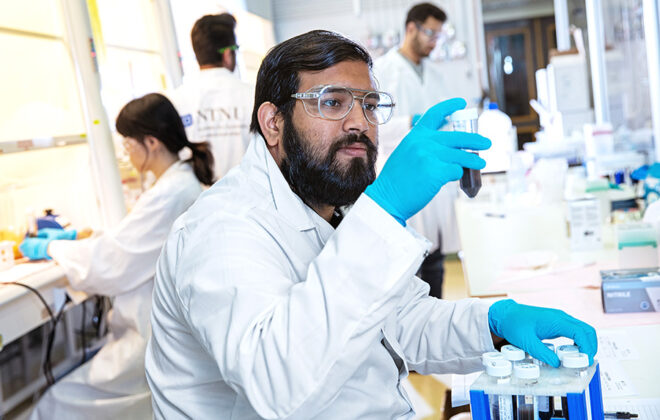When little things have a big impact
Sometimes, it’s the tiniest things that ruin the day, be it a mosquito in your bedroom, a splinter in your toe, or a tiny hole in the tube of your bike’s wheel. This can also be the case with oxygen in a CO2 capture process – there’s not much of it, but it can be pretty problematic.
One of the most used and best working ways of capturing CO2 works with a type of liquids called amines that can selectively bind themselves to the CO2 molecules. This reaction can then easily be reversed by heating up the liquid so that you can collect very pure CO2 that can be stored permanently underground. This is advantageous because it allows us to continuously use the same liquid amine without ever needing to replace it. Unfortunately, one issue that makes it necessary to replace the amine is degradation, or simply put, that the amine can break and lose its ability to bind CO2.
The reactions happen slowly over time and degradation often occurs in contact with oxygen present in the treated gas. A small part of the oxygen in the gas we’re cleaning will transfer to the liquid phase and oxygen concentrations less than 0.0001% are expected. As we would like to use the solvents for months and years, even these tiny amounts of oxygen in the liquid phase are important as any degradation will over time influence the performance of the CO2 capture process. Therefore, understanding the role of liquid phase oxygen has been the focus of many research projects over the years.

Challenges with such low concentrations
The fact that the concentration is this low gives us another challenge; how do you measure something that only occurs in such minuscule amounts? We surely can’t see it and hardly separate it from the rest of the mixture, so what to do? And also, how can we possibly remove something that there’s so little of and how do we know that we actually removed it?
These are things that we have looked into and learned a lot about in one of our latest scientific papers. We learned that in some cases you may use commercial dissolved oxygen sensors, designed for analyzing water, to get an idea of how much oxygen you have in the amine solution. You have to watch out though; we found out that some amines react with oxygen, or degrade, too fast for the oxygen sensor to work correctly. Luckily, this is not the case for all amines.
In our article, you can read more about that and how we tried to solve the measuring challenge with a computer model to predict oxygen solubility in amines.

Article in the International Journal of Greenhouse Gas Control
Measurement and prediction of oxygen solubility in post-combustion CO2 capture solvents


Hanna Knuutila
Hanna Knuutila is a professor and the deputy of education at the Department of Chemical Engineering at NTNU.
Tags In
Search
Søk
Categories
- Arctic Research
- Arkitektur
- Bærekraft
- Bioingeniørfag
- Biologi
- Biology
- Biomedical Laboratory Science
- Biotechnology
- Bioteknologi
- Chemical Engineering
- Chemistry
- Climate
- Computer Science
- Datateknologi
- Digital
- Elektronikk
- Energi
- Energi
- Energy
- Engineering
- Engineering
- Environment
- Food Science
- Forskning
- Fysikk
- Fysikk
- Havbruk
- Informasjonsteknologi
- Informasjonsteknologi
- Ingeniørvitenskap
- Kjemi
- Kjemisk prosessteknologi
- Kjemisk prosessteknologi
- Kreftbehandling
- Kybernetikk
- Marine Technology
- Materialer
- Materials Science
- Materialteknologi
- Matvitenskap
- Meninger
- Miljø
- Min ph.d.
- My PhD
- My PhD
- My postdoc
- Nanotechnology
- Nanoteknologi
- Ocean
- Oil and gas
- Physics
- Research
- Simulering og visualisering
- Spør en forsker
- Studentliv
- Sustainability
- Ukategorisert
- Universitetsliv
- University Life
Kategorier
- Arctic Research
- Arkitektur
- Bærekraft
- Bioingeniørfag
- Biologi
- Biology
- Biomedical Laboratory Science
- Biotechnology
- Bioteknologi
- Chemical Engineering
- Chemistry
- Climate
- Computer Science
- Datateknologi
- Digital
- Elektronikk
- Energi
- Energi
- Energy
- Engineering
- Engineering
- Environment
- Food Science
- Forskning
- Fysikk
- Fysikk
- Havbruk
- Informasjonsteknologi
- Informasjonsteknologi
- Ingeniørvitenskap
- Kjemi
- Kjemisk prosessteknologi
- Kjemisk prosessteknologi
- Kreftbehandling
- Kybernetikk
- Marine Technology
- Materialer
- Materials Science
- Materialteknologi
- Matvitenskap
- Meninger
- Miljø
- Min ph.d.
- My PhD
- My PhD
- My postdoc
- Nanotechnology
- Nanoteknologi
- Ocean
- Oil and gas
- Physics
- Research
- Simulering og visualisering
- Spør en forsker
- Studentliv
- Sustainability
- Ukategorisert
- Universitetsliv
- University Life




